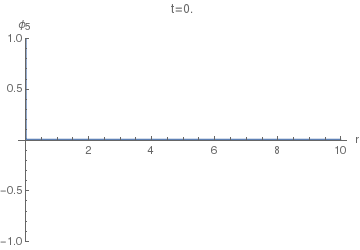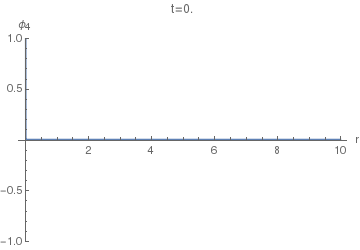What does a 4+1D wave look like at the light cone?
For ease of reference in this post equations are numbered as in ref. 1.
The equation $(36)$ cited in the OP reads
$$G_4(r,t)=\frac1{4\pi^2c^3}\left(\frac{\delta(t-r/c)}{r(t^2-r^2/c^2)^{1/2}}-\frac{\eta(t-r/c)}{c(t^2-r^2/c^2)^{3/2}}\right).\tag{36}$$
Here $\delta$ is the Dirac delta, and $\eta$ is the Heaviside step function.
By itself, this expression doesn't really help understand what's going on: the Dirac delta in the first term is multiplied by a function that is singular at the delta's distributional singularity, and the second term isn't integrable. So, even if there is some way to evaluate this Green's function as a distribution like $\langle G_4,h\rangle$ for a smooth test function $h$, I suppose the expression would have to be transformed somehow.
Let's go another way. Namely, start from how equation $(36)$ was derived. The authors in ref. 1 derived it by integrating the Green's function for (5+1)-dimensional wave equation,
$$G_5=\frac1{8\pi^2c^2}\left(\frac{\delta(\tau)}{r^3}+\frac{\delta'(\tau)}{cr^2}\right),\tag{32}$$
where $\tau=t-r/c$, along the line of uniformly distributed sources in 5-dimensional space, using the integral
$$G_{n-1}(r,t)=2\int_r^\infty s(s^2-r^2)^{-1/2}G_n(s,t)ds,\tag{25}$$
where $r=r_{n-1}$ is the radial coordinate in $(n-1)$-dimensional space.
Remember that a Green's function for a wave equation is the impulse response of the equation, i.e. the wave that appears after the action of the unit impulse of infinitesimal size and duration, $f(r,t)=\delta(r)\delta(t)$. For visualization purposes it's useful to replace this impulse with one that is finite at least in one variable, e.g. time. So let's choose another force function $f(r,t)=\delta(r)F(t)$, where $F$ is defined as the Gaussian function
$$F(t)=\frac1{\sqrt{2\pi}\sigma}\exp\left(-\frac{x^2}{2\sigma^2}\right).$$
Then, following equation $(34)$, we'll have the displacement response of the (5+1)-dimensional equation given by
$$\phi_5(r,t)=\frac1{8\pi^2c^2}\left(\frac{F(\tau)}{r^3}+\frac{F'(\tau)}{cr^2}\right).\tag{34}$$
Now, to find the displacement response $\phi_4(r,t)$ of the (4+1)-dimensional equation, we can use $\phi_5$ instead of $G_5$ in $(25)$. The resulting integral doesn't seem to have a closed form, so the following animations of $\phi_4(r,t)$ were done using numeric quadrature.
In the animations below we use $c=1$.
Let's first see how the $\phi_5(r,t)$ looks. This will enable us to compare it with $\phi_4(r,t)$. The following animation uses $\sigma=0.005.$

We can see that it basically has two spikes: one positive and one negative. Let's increase $\sigma$ to $\sigma=0.04$ to resolve them better:

Now we can finally look at $\phi_4(r,t)$. The following animation uses $\sigma=0.005$, as the first one above.

Notice the difference of this wave from the $\phi_5(r,t)$: the former has a "tail" inside the light cone, i.e. on the LHS of the positive spike here. This tail corresponds (in the limit $\sigma\to0$) to the second, negative, term in the equation $(36)$, while the positive spike corresponds to the first term with the Dirac delta.
So, the answer to
What does it mean that the Green’s function for the 4+1D wave equation has an opposite sign delta-function exactly on the light cone?
is exactly that: there is a negative wake inside the light cone and the opposite sign, i.e. positive, Dirac delta, i.e. infinitely high and narrow spike, on the light cone.
References:
1: H. Soodak, M. S. Tiersten, Wakes and waves in N dimensions, Am. J. Phys. 61, 395 (1993)